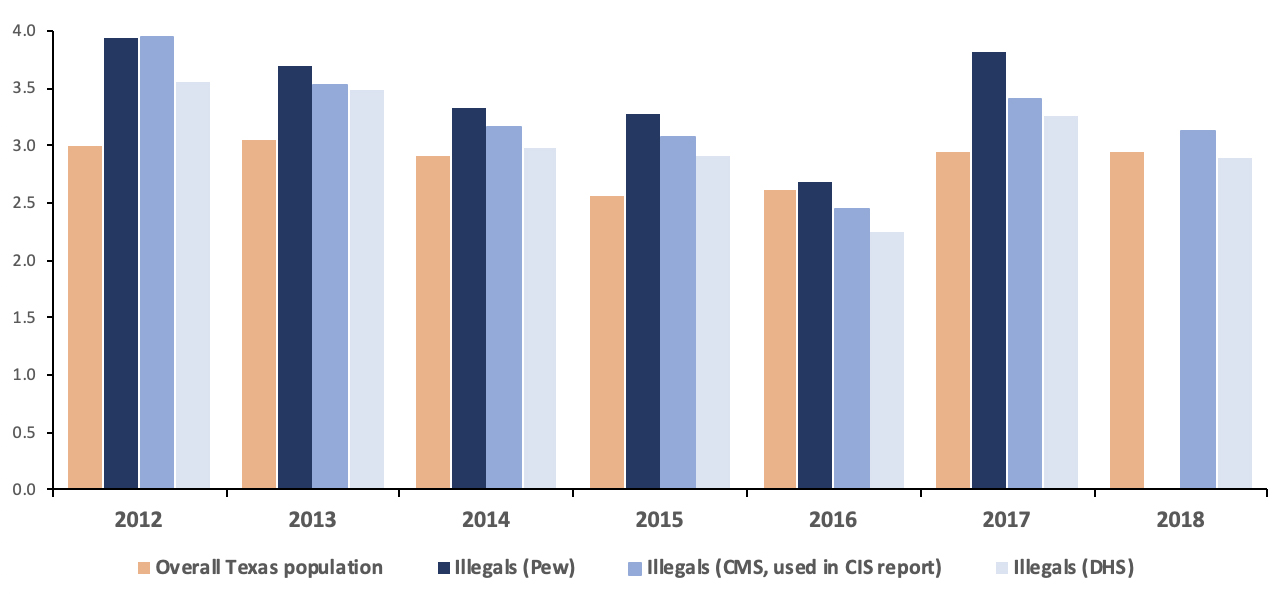Continued Misuse of Texas Crime Data
The Center published a report last week showing that illegal immigrants are convicted of crime in Texas at higher rates than previously estimated in a Proceedings of the National Academy of Science (PNAS) article and in a series of studies published by the Cato Institute. These studies understated illegal immigrant crime because they failed to appreciate the time it takes to identify illegals in custody. Some illegals are identified immediately upon arrest; others are identified later in prison; and still others may elude detection altogether if they are not in custody long enough.
Once we added the illegals identified in prison to the illegals identified at arrest, their homicide and sexual assault conviction rates appeared to be greater than the Texas average. We noted, however, that significant uncertainty persists as to how many illegals may remain unidentified, especially those who committed recent or lesser offenses requiring little prison time.
In responding to our critique, Cato’s Alex Nowrasteh repeats his prior mistake, then casts an unwarranted aspersion.
Still Missing the Illegal Immigrants Identified in Prison
First, Nowrasteh dismisses the data we obtained from the Texas Department of Public Safety (DPS) as an anomaly because he says he has newer DPS data that does not show as many homicide convictions of illegals as we do. He still does not understand that he is looking at the count of illegals identified at intake. As DPS personnel from the Crime Records Division have made clear to us, that count is not updated to include the burgeoning number of illegals identified in prison — those are tallied in a separate category.
To be more specific, DPS uses four immigration status categories: (1) legal immigrants, (2) illegal immigrants, (3) prison-identified illegal immigrants, and (4) unknown/other. The first two categories are identified upon intake through federal databases, while the third category (prison-identified illegals) is ascertained through in-custody investigations over time. The fourth category is a mixture of yet-to-be identified immigrants and native-born citizens.
By contrast, Nowrasteh’s DPS data is incomplete. It includes only the first two of the four DPS categories listed above (legal at intake and illegal at intake), with prison-identified illegals not included. We confirmed this with DPS after examining his records requests. He finds fewer convictions of illegal immigrants than we do because he is not looking at the full data.
Denominator Distraction
Nowrasteh includes some innuendo about our choice of denominator when calculating the illegal conviction rate. We used the number of illegal immigrants in Texas as estimated by the Center for Migration Studies (CMS), but the fact that we have sometimes in the past used alternative population estimates from the Department of Homeland Security (DHS) strikes him as suspicious.
Well, CMS is the same source used by the PNAS article and the first two Cato studies, making it the obvious choice for any re-analysis. CMS provides what Nowrasteh himself calls a “mid-range” estimate that is relatively close to what DHS, Pew, and others have produced. We have used CMS repeatedly over the years for a variety of purposes, including our recent state-level analyses. Most importantly, our choice of CMS makes hardly any difference in the results. (See the figures below.) The purpose of Nowrasteh’s denominator discussion was not to point out an actual methodological problem; rather, he simply wanted to accuse us of bad faith.
Figure 1. Homicide Convictions in Texas per 100K |
|
Source: Texas DPS (convictions); Pew, CMS, DHS (illegal population); ACS (overall population). The parentheticals in the legend indicate the organization that produced the estimate of the total illegal population in Texas in the given year. This estimate is the denominator of the conviction rate calculation. The numerator is the number of known illegal immigrant homicide convictions, including illegals identified in prison. Some illegals may remain unidentified, especially in more recent years. No Pew estimate is available for 2018. |
Figure 2. Sexual Assault Convictions in Texas per 100K |
 |
|
Source: Texas DPS (convictions); Pew, CMS, DHS (illegal population); ACS (overall population). The parentheticals in the legend indicate the organization that produced the estimate of the total illegal population in Texas in the given year. This estimate is the denominator of the conviction rate calculation. The numerator is the number of known illegal immigrant homicide convictions, including illegals identified in prison. Some illegals may remain unidentified, especially in more recent years. No Pew estimate is available for 2018. |





